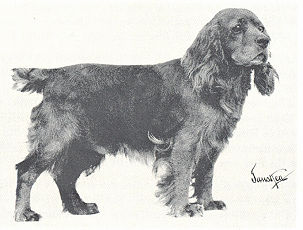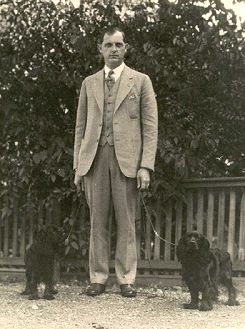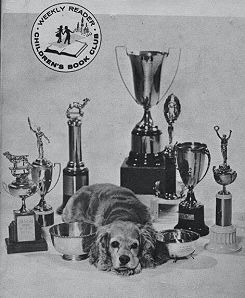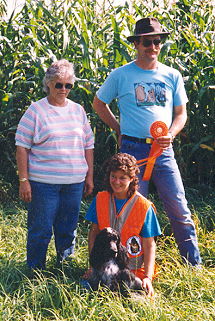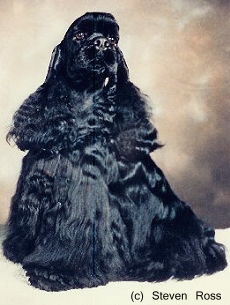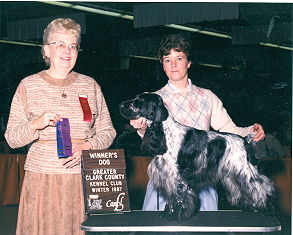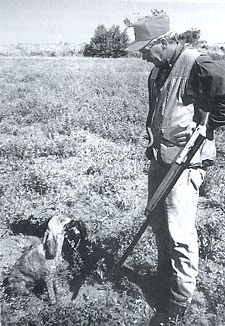 
Breed Standards as Guides to Rules
Early efforts to stabilize cocker type in England, Canada and the United States relied on inbreeding - particularly on a field spaniel, Eng. CH Brush, and cocker, Eng. CH Obo together with other descendents of Phineas Bullock’s Bebb, and his son, Young Bebb (or Bebb or Spurgin’s Bebb) who was owned by Mr. Spurgin. Breeders worked to fix those physical traits they felt would make the dog more useful in the field. Sometimes it required an outside cross, and in those early days, they’d breed to Sussex, field, springer or Norfolk spaniels - or sometimes, to Clumbers and setters.
At the time, small hunting spaniels were all called cockers and English born dogs were bred with American and Canadian born dogs. Americans were exported to England and English brought into North America. Though most of the time these dogs were both shown and hunted over, some breeders already felt there was a difference between dogs used primarily for hunting and those who were also shown. Clinton Wilmerding was a voice of reason for ASC as well as AKC in the early days. A hunter and advocate of hunting cockers throughout his life, yet even Wilmerding could not sustain enough interest by hunters in the United States to use cockers in the field. He resigned from a gasping field trial committee and there was little interest in field events for 20 years.
The AKC recognized the English Springer Spaniel Field Trial Association in 1926. They’d held their first field trial for springers in 1924 at Fisher Island, New York. Also, in 1924, Ella B. Moffitt pulled together sportspeople to form the Hunting Cocker Spaniel Club. They held their first field trial for cockers that same year. While there weren’t many entries - and none of the dogs were trained, they did okay. But the show was stolen by seven month old, Rowcliffe Diana who flushed and retrieved full-grown pheasants to win the puppy stakes.
With a need for breeder and judges’ education on how to train hunting cockers, English judges were invited to the US to guide sportspeople. The following year, the Hunting Cocker Spaniel Club held a second field trial at Verbank, New York. The entry of 36 included fourteen springers who ran in a "courtesy stake" for springers, and all were improved - dogs, handlers and judges - with the year’s training from the British judges. Imported dogs were not allowed in the regular classes, but ran in special international-all-age stakes to showcase the more refined skill of the English-bred dogs.
The trial was won by American cocker, Rowcliffe War Dance, owned by Mrs. A. R. Moffitt, trained and handled by Elias Vail. Mrs. Moffitt, together with other breed leaders in the 30’s and 40’s, advocated for the comprehensive cocker: a dog with correct type, structure and demonstrated field ability.
By 1930, the American type of cocker was gaining public attention. The sire of Herman Mellenthin’s famous, Red Brucie, was Robinhurst Foreglow, owned by Hon. Townsend Scudder. Foreglow was different from other cockers of the day being more up on leg and short backed. A trait sportspeople were looking for in their working dogs.
The dog was offered at stud for no cost to typical cocker bitches of the day. Two astute breeders took advantage of the offer and wrote cocker history with puppies born from those breedings. They were Herman Mellenthin (My Own) and William T. Payne (Midkiff).
Mellenthin believed if a dog had good conformation and bone plus carried himself well in the show ring, it would have a nose for game and be a good prospect to become a field trial winner. He proved it with his dogs and helped others learn how to see and breed for it, as well. Among his dogs was the first dual champion, CH FTCH My Own High Time, and the two time Westminster Kennel Club, Best in Show winner, CH My Own Brucie.
Popularity of Cocker Field Trials Ebb and Flow and All But Dry Up
Interest in field trials grew and in 1929, the Hunting Cocker Spaniel Club changed its name to the Cocker Spaniel Field Trial Club of America. They held a trial in October 1931, judged by David Wagstaff and Captain Paul A. Curtis. Among those there were Ralph C. Craig, Henry Ferguson, Elias Vail, Dr. Samuel Milbank, and H. E. Mellenthin.
American Spaniel Club field trials increased and often had entries of more than sixty dogs. Hunt clubs formed around the United States over the next ten years with one especially active group being the Spaniel Field Training Club of Northern California. Formed in 1936, they trained during the summer and held a demonstration day in the fall. They invited the press and had 300 people attend with 100 dogs. People were excited to learn how to train their dogs for the field. In time, dual champion, CH FCH Don Pablo from Jourdains, would earn one of his five-point wins at a field trial held by this club.
In 1946, the American Kennel Club recognized English cockers as a separate breed. Up to then, they were known simply as cocker spaniels. In the United States, the American type is still officially known as the "cocker spaniel" but is known as the "American cocker spaniel" elsewhere. Until that time, the two types of cockers could be interbred, though the English Cocker Spaniel Club of America established a resolution in October 1938, which stated that their club members would not interbreed the English with the Americans, or allow their studs to be used on American bitches. They also established that “an English Cocker Spaniel is defined as a dog or bitch of the cocker spaniel breed whose pedigree can be traced in all lines to dogs or bitches which were registered with the English Kennel Club (or eligible for export pedigree) on or before January 1, 1930.”
"Field trialing is a very expensive and time-consuming sport involving a lot of travel. Professional training and handling were essential. It was impossible for an average fancier to be competitive." p. 428 Vol. 1"
Registrations of American cockers increased steadily and represented the majority of the entry at field trials before World War I. The War years reduced dog sports of all kinds, but when the wars ended, only two trials remained, both in the east. American cockers were all but gone from trials they’d dominated ten years earlier. Cocker field trials entries were almost entirely English cockers.
Dr. J. Eugene Dodson, a dentist on the west coast, was committed to the be-all cocker. He trained and titled both American and English cockers as gundogs and show. Between the two breeds, he saw the American’s competitive advantage slipping in field trials.
In an article in Dog News, published in June 1948 and reprinted in the ECSCA 's Jubilee book, he wrote about his own dogs and what he saw coming: "At the present time we have two good American field trial prospects in the kennel. However, as long as the two breeds (English and American) must run against each other in the stake I see no use to train them. I hazard the guess that the records will bear me out, that the wins of the English Cocker Will become more frequent and unless the AKC takes steps to separate the two breeds, the American will have a hard time doing any winning where English are entered…” p. 409.
Hunting Up New Interest for Field Ability
The American Spaniel Club rallied again to hold the first Cocker National Field Trial in 1953. It was held at the Crab Orchard Wildlife Refuge in Herrin, Illinois. Henry Berol of Berol Lodge Kennels in New York was chair of the Field Trial Committee and vice president then and he convinced the Board that all cockers would benefit from a national championship field trial event.
Qualifiers had to place in one of the recognized Open All-Age stakes held in 1953. The average stake included 20 dogs, and this gave the National event a qualifying pool of about 30 dogs. There were 20 entries: eleven American cocker spaniels and nine English at the first ASC hosted, Cocker National Field Trial. All started. The judge was Arthur M. Lewis (Monty) of Stamford, Connecticut and with him, was the highly respected professional gundog trainer, Elias Vail. The trial was won by NFCH Camino’s Cheetah, a four and a half year old, English cocker bitch owned by H.C. (Dan) McGrew, California, and handled by J. Stanley Head.
English cockers dominated the yearly national event until 1956 when an out of the blue cocker contender walked away the winner. This was NFCH Prince Tom III, U.D., who was six and a half years old, trained and handled by novice, Tom Clute, of Michigan. The trial was held on the Amwell Game Preserve at Ringoes, New Jersey. It consisted of five land series on pheasants and two water series on flown ducks. There were seventeen starters in the nineteen-dog entry.
Prince Tom was the first cocker to win the National. Previous winners were all English and two of them were imports. Among other firsts, Prince Tom was the first National Field Champion to hold obedience titles, the first amateur handled cocker, and the first Midwest dog to win the National. Clute was not a hunter and Prince Tom had been given to him as a birthday gift.
In 1957, FCH Berol Lodge Glen Garry, a six-year-old cocker, bred and owned by Henry Berol and handled by Blair Crowell, won the National Cocker Championship.
But by 1959, interest faded again and Berol’s frustration was apparent in his annual report to the ASC board. The report appears in the 1959 American Spaniel Club book and he wrote, "It is with deep regret that I have again accepted the 1959 Chairmanship of your Field Trial Committee..." And goes on, "I regret this deeply because we delved into the question of a successor and unfortunately none could be found who could fulfill this task for the coming year."
"However, with the assurance that Mr. Albert Winslow will take over the reins in 1960 and with the assurance that Mr. Jim Greening will again serve as Secretary of the Field Trial Committee, with great reluctance I accepted this position."
Berol’s Buckaroo won the National in 1960, handled by his owner, Hartwell S. (Bucky) Moore, Huntington, LI, NY. Buckaroo also won the amateur shooting dog stake held after the National event. Third place went to FCH Ru-Char’s Citation, bred and owned by Mr. and Mrs. Charles Greening, Mahwah, NJ, and handled by Mrs. Greening.
The Almost Last Cocker National Field Trial
Albert Winslow, the chair of the ECSCA Field Trial Committee, said in his report that there were few English cockers entered in the 1962 stakes, few placed and the number of field trial fanciers were quickly diminishing.
The 1962 National Field Trial was won by Ru-Char’s High Jinks, owned and handled by Ruth Greening. The entry of nineteen included ten dogs from two kennels alone, as reported by ASC Field Trial Chairman, Peter D. Garvan. There were not enough entries to hold a quality stake in 1963, he wrote, and the financial burden to the club ended the ASC National event.
Speculation on what happened to discourage field fanciers is mentioned in the ECSCA Jubilee book, "In an attempt to give each dog an identical tests, the trials had become increasingly artificial. When competition was very keen and as the trainers and dogs improved, the tests became more and more impractical in comparison with situations that might occur in a "normal day’s hunt". In order to find a winner the judges were forced to emphasize speed, style and obedience rather than thoroughness, controllability and common sense. And of course, finished field champions, including national champions, continued to compete in the Open All-Age stakes. They were tough to beat.
"Field trialing is a very expensive and time-consuming sport involving a lot of travel. Professional training and handling were essential. It was impossible for an average fancier to be competitive." p. 428 Vol. 1.
Still Going and Growing in England
While cocker trials essentially ended in the United States during this time, they flourished in England. In 1983, Jeann Silver reported on a cocker trial she attended in Scotland. She noted differences in judging with a third referee judge working with the two in case of indecision. And entries limited to sixteen per stake with reserves for no shows. It was a two-day trial and she admired the "hard running dogs, dogs with fine scenting ability, hard flushes and soft retrieves and responsiveness to their handlers." But she also noted a striking difference she attributed to training, not breeding.
"It is not the intent of the testing program to reward mediocrity - rather, the goal is to provide tangible and visible AKC recognition to those excellent pure-bred dogs that serve as hunting companions."
"Their ‘casts’ would be considered short by American standards... The British dogs seem to have been trained to run a tighter pattern and their casts were about two-thirds of what I am accustomed to." p. 428.
Another difference she mentioned was that in British trials, birds were not planted. Dogs had to find wild pheasants and Silver complained it was boring. She didn’t understand how a dog that didn’t find a bird could be judged against a dog that did.
Competing dogs also worked on rabbits.
Another Rush: Testing a Working Dog
In the 1970’s, AKC field events for spaniels were limited to competitive field trials. Hunt tests for spaniels didn’t exist yet. ASC Field Trial Committee Chair Frank Wood worked with the San Gabriel Cocker Spaniel Fanciers club in California to try to hold field trials for cockers again, but there wasn’t enough interest. A new generation of cocker fanciers needed ways to become involved and learn how to train their dogs to hunt. The English Springer Spaniel Field Trial Association had a Working Dog Test program in place and Wood used it as the model for a proposal made to the board of the American Spaniel Club in 1976. Wood and his wife,
Dee Dee, took a red eye flight to attend the meeting, but before they could present their proposal, another Board member brought a different field proposal to the table. Wood was unaware of it and startled because it suggested a program where hunting ability could be evaluated without live birds or the use of guns. Angry, he argued hunting dogs could not be evaluated without birds or guns. Anything less than the Working Dog test he proposed would damage the breed - hunting being a combination of dog and owner training. At the end of the meeting, Wood’s Working Dog Test proposal was approved.
California Hosts the First ASC National WD/WDX Test
The first ASC Working Dog test held in connection with the annual, ASC National Cocker Spaniel Specialty show was held in 1978 in Huntington Beach, California. Nine cockers, four English cockers and one springer were entered. Seven of the cockers earned WD titles and two earned Working Dog Excellent titles. The second national test was held in Cincinnati, Ohio the following year. The judge was Dennis Blake of Orange, California. Six dogs ran and three WD and one WDX were awarded. The grounds belonged to a well-known springer trainer and had seven ponds with many different covered fields. The third test was well in place by the third national event in 1980, held in Tampa, Florida. The judge was Charles Rowe of San Diego, California. There was one WD and one WDX awarded.
The Working Dog test accomplished its primary goal - introducing a new generation of cocker fanciers to the hunting capacity of their dogs. In 1983, ASC Field Committee Chair, Kenna Giffin reported ASC was again approved to hold AKC sanction B field trials. And in 1984, ASC held its first field trial during the National Cocker Spaniel Specialty show in Lincoln, Nebraska. Both field dog and bitch classes were added to the national events including the National Flushing Spaniel Show held in January. ASC Field Committee Chair, Ruth Tabaka of Washington, revised the Working Dog Test rules to clarify them, and sections on philosophy and reporting procedures were added during this time. She also developed a introduction to gundog training as a guide for people interested in beginning fieldwork and judged field events. Then came the Hunt Tests.
Creative Inclusion; AKC Offers Hunt Tests
In April 1985, the American Kennel Club’s Field Trial department sent a letter to all spaniel parent clubs announcing a new "experimental program" where spaniel breeds could be tested against a hunting standard. There were guidelines with performance standards for testing three levels, along with score sheets. Any club already licensed to hold field trials, could hold a sanctioned Plan A hunting test. Clubs who were restricted to holding Plan B field trials, could apply to hold a Plan B hunting test. AKC offered the new tests based on the good results they’d had with their new hunting retriever test.
Different from the competitive, professional environment around field trials, hunting tests were to encourage owners of purebred spaniels to measure the ability of their dogs as hunting companions in tests that were most like true hunting conditions. It was a utility test for hunters, who weren’t interested in field trials, but liked the measure of their dog’s ability. Dogs earning hunt test certifications had a suffix designation "carried on a dog’s registered name and in all official AKC records". These designations were JH, Junior Hunter, SH, Senior Hunter, and MH, Master Hunter.
The letter sent to the parent clubs reads, "It is not the intent of the testing program to reward mediocrity - rather, the goal is to provide tangible and visible AKC recognition to those excellent pure-bred dogs that serve as hunting companions..." and was signed by "A. Hamilton Rowan, Jr., Director of Field Trials & Hunting Tests".
At the time, there was only one club other than the American Spaniel Club sanctioned to hold field trials for cockers. That was Washington State Cocker Spaniel Club. The English springer spaniel people held their events for springers almost exclusively, and were not keen on encouraging the casual hunter or show dog owner to test their dogs above the Working Dog certificate. It looked for a while, like the program would be lost because of "lack of interest" on the part of the organizations more barrier than assistance to clubs.
Then on July 13, 1988, the American Spaniel Club hosted the first AKC Hunt Test for flushing spaniels in connection with its National Cocker Spaniel Specialty show. Jeffrey Miller DVM and Wayne Kilpatrick judged - and the test drew entries from Washington, Oregon, California, Arizona, Minnesota, Colorado and Iowa. The twenty-five entries included cockers, English cockers, Clumbers, Welsh springers and English springer spaniels. Call backs to the water included one American cocker, one English cocker and three springers who all qualified.
The first cocker to qualify at that test was Deidree Shannon Dodge UDT WDX JH SH, owned and trained by Debra Dodge, now Debra St. Myers, of Olympia, Washington. Deidree was the first cocker to earn a Senior title, with Am/Can Ch. Tabaka's Tilt The Balance CDX WDX SH, Trucker, being the first champion to earn a Senior title. His son, Lyndale's Mr. Deuteronomy CDX WDX JH owned by Barbara Rettig, was the first Junior Hunter titled dog of any breed, according to Ruth Tabaka.
Keep on, Keepin’ on; Cockers Flushing Anew
Cocker clubs continued to forge ahead in all three areas to encourage owners to learn about their breeds’ field ability. They held Cocker Fun Field Days to introduce owners to hunting with cockers. Clubs held Working Dog tests, field trials and the new hunt tests.
In 1984, the Washington State Cocker Spaniel Club included Clumber and American water spaniels in their Working Dog tests for the first time. And Fronci Knifong of Roseville, California, said in Norman A. and Jean S. Austin’s book, The Complete American Cocker Spaniel that by December 1991, seventeen cockers earned Junior Hunter titles and seven earned Senior Hunter titles.
In 1995, the first Master Hunter titled cocker was CH Pett’s Southwest Breeze, CD, WD, SH, MH - called "Ruby". Bred by Elsie Scolaro and Anne Noble, Ruby was owned, trained and handled by Trish Jackson of West Falmouth, Massachusetts. When Ruby tragically died in the field at nine years old, grief rippled through the cocker fancy. People felt a deep connection to the little cocker bitch who so visibly carried fieldwork forward for the breed. Within ten days, people from around the world donated more than $2000 to establish the ACS Ruby Memorial Award in her memory. A Perpetual Memorial Trophy, it is a loving tribute to a fine example of the breed, from a long line of notable cockers. The Ruby Memorial Award recognizes type, trainability and talent and is awarded to all cockers attaining the titles she carried when she died.
In 2001, Trish Jackson bred, trained and handled the first cocker spaniel field champion in almost thirty years, a Ruby daughter, FC Madison’ Pride and Passion MH, sired by Bazil’s Stylish Pride JH SH.
Since Ruby earned her MH title, seven more cockers have earned it, too. Poised to be the second recipient of the Ruby Memorial Award (Ruby was the first), is CH Kapewood’s Makin’ Out (Megan) TD JH SH MH who earned her Master Hunter title in the fall of 2004. Megan is the second breed champion and Master Hunter, and was bred by Carolee Douglas, Phoenix, Arizona, and Betty Lawson, Albuquerque, New Mexico. She is owned by Carolee and trained and handled to her title by Pat Perry and Carolee.
English cockers moved forward in hunt tests sooner, with the first English cocker spaniel breed champion to earn a Master Hunter title being Am. and Can. Ch. Ranzfel Quarrystone UDT WDX JH SH MH who completed his title in 1990. Stoney was bred by Virginia Lyne, and was owned and handled by Tawney Crawford, Quailmoor in Washington. Stoney was the first English Cocker to earn Junior, Senior and Master Hunter titles.
Recently, he was joined by three English Cocker bitches who, on October 2004, earned their Master Hunter titles. Together, they share the distinction of being the first bitches to be both breed champions and Master Hunters. They are Ch. Carefree's As Good As It Gets CD MH NA WDX TT CGC bred by Amy Kluth and owned, trained and handled by Paul Mommaerts, both of Green Bay, Wisconsin; Ch. Beauty-Madonna vom Ehrhornsgund JH SH MH, born in Germany and owned by Karen Fremuth and Virginia Boylan; and Ch. Graecroft Seasyde Blue Moon VCD 2 JH SH MH AX AXJ, owned by Cortney Oliver and Helyne Medeiros.
Cocker field trials were reborn in 1993 when the Rocky Mountain Springer Spaniel Association agreed to host an event. Twenty-five dogs entered the open and three in the puppy stakes. Open judges were Stan Wrobel and David Jones. Puppies were judged by Cindy Goode and Sue Seller Rose. FCH Parkbreck Moorhen, bred by C. R. Colclough, owned and handled by Paul McGagh, then of Virginia, won the open. In 1995, Moorhen finished her field championship.
On February 19, 1994, an ad hoc committee meeting organized by Vance Van Laanen from Wisconsin, discussed the future direction of cocker trials. People were concerned that English cockers not become miniature springers because of "mismanagement of cocker field trials" (Jubilee, Vol. 3, pg.234). Cockers should be able to trial and hunt.
The outcome set forth changes to the Field Trial Rules for Cocker Spaniels. First, the number of entries required for a qualifying open all-age stake increased from six to ten, and then the same field championship point schedule used for springers is now used for cockers. These two changes were approved by the AKC Board of Directors, effective August. 1,1994.
The first English cocker to earn an AKC Field Championship since the 1960’s was American and English FCH Omachie Tarf, bred by M. Forbes of Scotland, owned by John and Shelia Courts, and handled by Kevin Martineau of Minnesota. Tarf earned his FCH title in 1993 - winning three out of four open all-age stakes offered that year.
Today, field bred English cockers from stock recently imported from England, tend to dominate cocker field trials. The English Cocker Spaniel Club of America resurrected the Cocker National Field Trial Championship in 1998 and offers it annually. But the concern voiced by people back in the 50’s - that the sport had moved to levels that required professional trainers and handlers plus significant dollars to finance the dog’s career, once more shadows the average person who wants to participate.
But this could change. While the parent club sponsored Working Dog tests opened one gate and AKC Hunt Tests another, on the horizon is the possibility of Cocker Field Trial Amateur Stakes that might provide yet another avenue for cocker sportspeople to have a competitive "gaming field dog" too. The English Cocker Spaniel Club of American and the American Spaniel Club submitted a request to AKC in early 2005 to allow Amateur Stakes in cocker field trials.
Yet, it is the cocker spaniel that remains the all around dog, Fronci Knifong so perfectly describes as follows:
"The characteristics that make the cocker one of the most popular of the purebred dogs are the same traits valued when this breed was first developed as a hunting dog. Trainability, desire to please, enthusiasm, friendliness, and intelligence are necessary traits in a hunting dog. The cocker was bred as a hunting dog that is tuned into the wishes of his master. This dog is a people dog. He wants to keep in contact with his owner. This attentiveness is an essential trait in a close working spaniel. These breed characteristics, plus the cocker’s "joie de vivre" and boundless energy have made training a hunting cocker a very rewarding experience."
Many thanks to ASC Curator, Wilma Parker, and ECSCA Secretary, Kate Romanski, for their help with the dates, photos and review of this piece. Stoney's photos courtesy of Tawney Crawford.
References:
|
|
|
| Bookstore | The Bookshelf | Advertise on SJ | Classifieds | Resources | Events | NEW! Point Standings | Letters | Archives | Spaniel Journal | |
